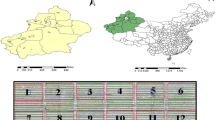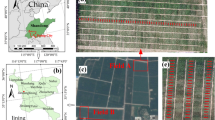Abstract
In this paper thein-situ experiment data are collected from the Spectral Library to estimate the possible values of the primary structural parameters in each cotton growing season by statistics. Based on these values the spectra of the cotton major growing seasons were simulated and analyzed using the canopy reflectance model, SAILH. In this way we also simulated the cotton pixel spectra corresponding to CBERS-02 CCD and took them as the reference spectra for spectra fitting. Then No. 143 Regiment of No. 8 Agricultural Division of Xinjiang Production and Construction Corps (XPCC) was chosen as the study area, and two spectra fitting methods, Mahalanobis distance and spectra angle, were used to identify cotton pixel from CBERS-02 CCD image of the study area. At last we analyzed the effect of the calibration coefficients error on cotton identifying. The results showed that within 4% error the spectral angle classifier can still have a good performance.
Similar content being viewed by others
References
Yang, B. J., Pei, Z. Y., Jiao, X. F., Cotton growing area monitoring in northwest China using CBERS-01 data based on satellite remote sensing. Transactions of the CSAE, 2003, 19(6): 146–149.
Cao, W. B., Yang, B. J., Song, J. P., Spectral information based model for cotton identification on landsat TM image. Transactions of the CSAE, 2004, 20(4): 112–116.
Li, J., Liu, Q. H., Liu, Q. A., Spectral-lib based algorithm to pick up pure crop pixels from hyperspectral image [A], Proceedings of IGARSS04[C], 2004, II: 1273–1275.
Verhoef, W., Light scattering by leaf layers with application to canopy reflectance modeling: The SAIL model, Remote Sensing of Environment, 1984, 16: 125–141.
Kuusk, A., A fast, invertible canopy reflectance model, Remote Sensing of Environment, 1995, 51: 342–350.
Bacour, C., Jacquemoud, S., Tourbier, Y., et al., Design and analysis of numerical experiments to compare four canopy reflectance models. Remote Sensing of Environment, 2002, 79: 72–83.
Zarco-Tejada, P. J., Rueda, C. A., Ustin, S. L., Water content estimation in vegetation with MODIS reflectance data and model inversion methods, Remote Sensing Environment, 2003, 85: 109–124.
Xu, X. R., Physics of Remote Sensing, Beijing: Peking University Press, 2005.
Li, X. Y., Gu, X. F., Min, X. J., Radiometric cross-calibration of the CEBERS-02 CCD camera with the TERRA MODIS, Science in China, (in press).
Goel, P. K., Prasher, S. O., Patel, R. M. et al., Classification of hyperspectral data by decision trees and artificial neural networks to identify weed stress and nitrogen status of corn. Computers and Electronics in Agriculture, 2003, 39: 67–93.
Qian, D., Chang, C. I., A linear constrained distance-based discriminant analysis for hyperspectral image classification. Pattern Recognition, 2001, 34: 361–373.
Han, K. S., Jean, L. C., Lean, L. R., A land cover classification product over France at 1km resolution using SPOT4/VEGETATION data, Remote Sensing of Environment, 2004, 92: 52–66.
Lenio, S. G., Antonio, R. F., Daniela, A. T., Discrimination of sugarcane varieties in southeastern Brazil EO-1 Hyperion data, Remote Sensing of Environment, 2005, 94: 523–534.
Sohn, Y., Sanjay, R. N., Supervised and unsupervised spectral angle classifiers[J]. Photogrammetric Engineering & Remote Sensing, 2002, 68(12): 1271–1280.
South, S., Qi, J., Lusch, D. P., Optimal classification methods for mapping agricultural tillage practices. Remote Sensing of Environment, 2004, 91: 90–97.
Chen, S. S., Remote sensing method of pure crop pixel identification & planting area estimation based on spectral library, Dissertation for the Doctoral Degree, Library of the Chinese Academy Sciences, 2005.
Author information
Authors and Affiliations
Corresponding author
Rights and permissions
About this article
Cite this article
Li, J., Liu, Q., Liu, Q. et al. Cotton pixel identification with CBERS-02 CCD data based on spectral knowledge. Sci. China Ser. E-Technol. Sci. 48 (Suppl 2), 129–144 (2005). https://doi.org/10.1007/BF03039430
Received:
Issue Date:
DOI: https://doi.org/10.1007/BF03039430




